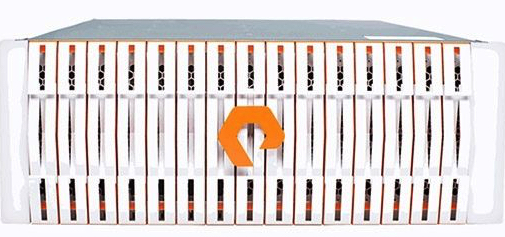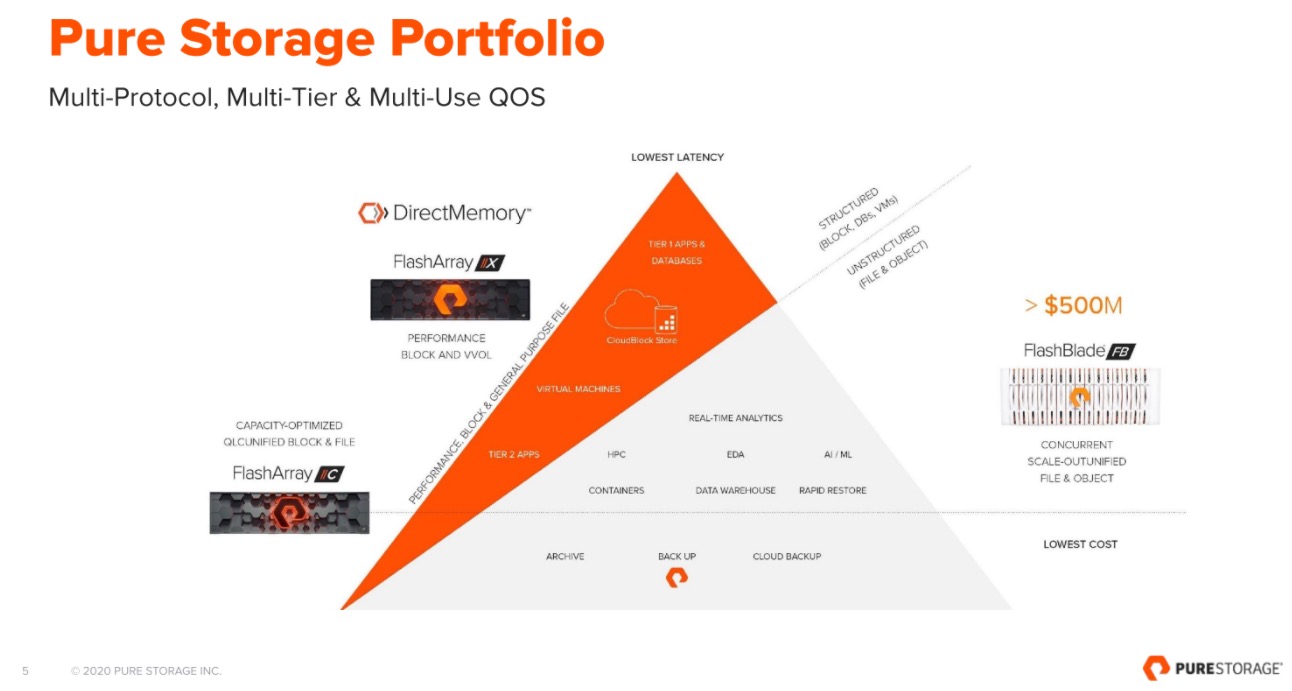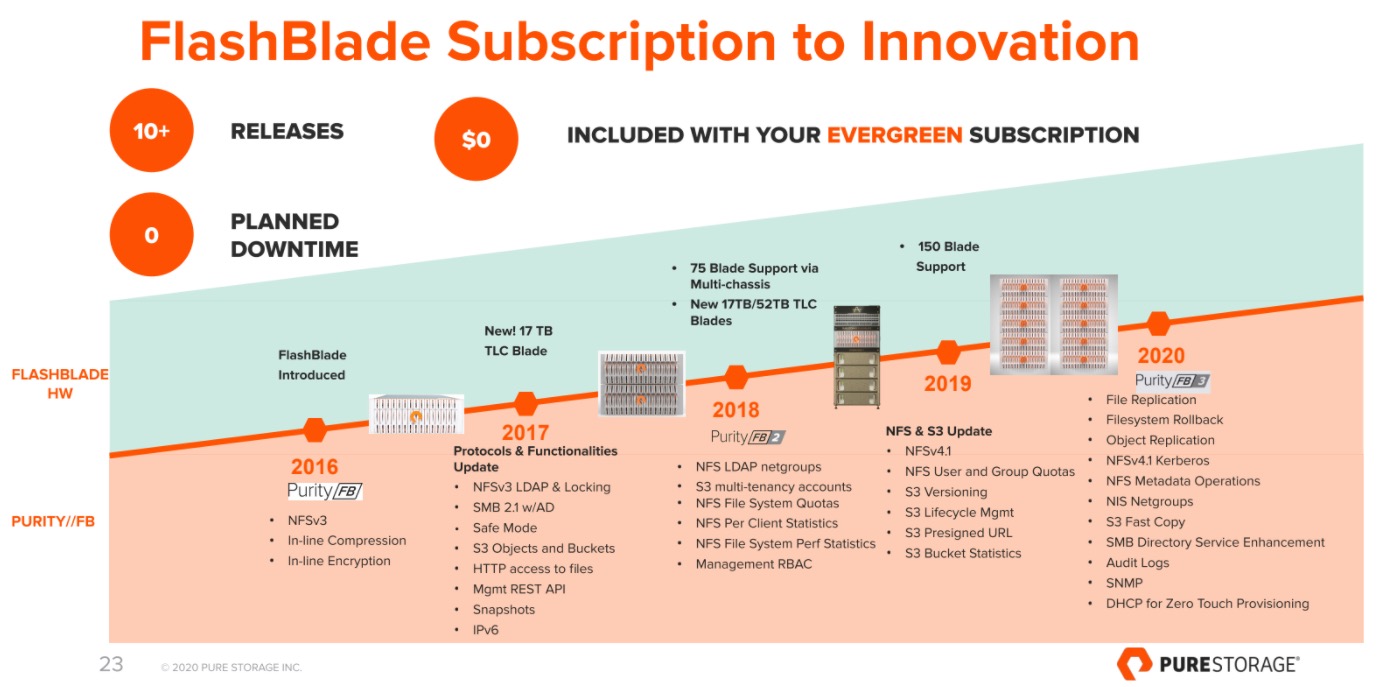Pure Storage Expands FlashBlade, Native Unified, Fast File and Object Platform
Software enhancements let workflows take center stage, help enterprises realize potential of real-time analytics.
This is a Press Release edited by StorageNewsletter.com on May 6, 2020 at 2:27 pmPure Storage, Inc. announced the availability of Purity//FB 3.0 for FlashBlade, a storage software for unstructured data. FlashBlade delivers an unified, scale-out fast file and object storage platform purpose-built to support modern application development, modern analytics and next-gen data protection.

FlashBlade has the ability to accelerate applications and enable data to be shared across applications and workloads. The latest updates to FlashBlade enable real-time performance that allow application workflows to take center stage – resulting in a Modern Data Experience that replaces complexities and antiquated systems with fast, flexible and agile solutions built to fit modern needs.
“FlashBlade is so unique because it is designed from the ground-up for tomorrow’s data pipelines and real-time analytics applications, with simplicity, ease of use and performance in mind — something that legacy storage vendors struggle with,” said Matt Burr, VP and GM of FlashBlade. “It delivers multi-dimensional performance and provides an unparalleled customer experience in the scale-out, unified file and object storage market.”
Architected to help customers achieve better resource utilization for compute and storage, FlashBlade reduces the complexity that arises from data silos. It extends this approach to key enterprise features such as replication for file and object and file system rollback, and allows data scientists and data architects to realize the potential of the models they design and create, faster.
“FlashBlade has helped us make exponential improvements across company operations, critical innovation centers and end-user experience. We’ve seen a 45% reduction in our need for storage space, and critical customer reports that used to take a month and a half to run are now ready in about half an hour. That means real, actionable insights for our customers weeks ahead of schedule,” said Chris Murley, Director of Network Operations, TownNews.com. “Most importantly, our infrastructure team is made up of software developers whose talents and passions are best suited for new projects and initiatives. With FlashBlade, our team can take a hands-off approach to storage management, which frees up critical resources to focus on the priorities most important for our customers.”
Purity//FB 3.0, the scale-out software that powers FlashBlade, delivers the same simplicity and ease of use for the new capabilities that customers have come to love and expect from FlashBlade. Pure-as-a-Service, an OpEx model, allows customers to leverage FlashBlade via a flexible consumption model.
“As a managed service provider in the financial sector, our clients adopt technology quickly and demand the highest levels of reliability, performance, and time to market. Pure continues to enable our growing client base to leverage the latest in block, file, and now high-performance object storage both within our data centers and across our global backbone,” said Micah Kroeze, VP or product-managed colocation, Options IT. “Pure allows us to scale smoothly and deliver a flexible consumption model to our dynamic client base, ensuring that our clients benefit rapidly from new developments in storage technology. Our recent expansion into Pure Storage FlashBlade technology, in addition to driving innovative product development within Options, provides our customers the opportunity to maximize data and analytics for a competitive edge in the financial services industry.”
Purity//FB 3.0 delivers capabilities that can address challenges including:
- File Replication: Enables the disaster recovery of file systems. Read-only data in the target replication site enables data validation and DR testing.
- Object Replication: Replication of object data between 2 FlashBlades improves the experience for geographically distributed users by providing lower access latency and increasing read throughout. Replication of object data in native format from FlashBlade to Amazon S3 delivers cloud mobility. Customers can use cloud for a secondary copy, or use public cloud services to access data generated on-prem.
- File System Rollback: File system Rollback is a crucial file system data protection feature. It enables the fast recovery of file systems from snapshots.
- NFS v4.1 Kerberos: Kerberos delivers security by authenticating users connecting to NFS v4.1 file systems on FlashBlade.
- Audit Logs and SNMP Support: Key enhancements to enterprise readiness by delivering improved security, alerting, and monitoring capabilities.
Unlocking the Potential of Modern, Real-Time Analytics
Virtually all analytics vendors have begun a shift to cloud-enabled architectures, such as Splunk SmartStore and Vertica Eon Mode. Built to deliver performance, agility and simplicity, FlashBlade is suited for these environments. Internal tests show that it delivers 80x faster query performance than traditional object storage platforms that disaggregate storage and compute. Consistently fast query performance enables faster time to insights for customers, and represents a business-critical advantage in the case of a security breach or ransomware attack. FlashBlade also allows administrators the freedom to scale their compute layer up or down as-needed, and slow administrative tasks are a pain point of the past.
“The adoption of object storage, driven by the rise of real-time analytics in the enterprise, is rapidly expanding, now sitting on equal footing with file storage. This creates a need in the industry for a storage architecture built from the ground-up to provide both native fast file and native object storage,” said Steve McDowell, senior analyst, Moor Insights & Strategy. “Flashblade is the industry’s first native fast file and object storage platform. FlashBlade allows customers to easily scale performance and capacity for both file and object, invisible to the application, leading to a simpler user experience and more impactful outcome for customers.”
Comments
Pure Storage started in 2009 with a total of $530.9 million (source Crunchbase) raised before the IPO made in October 2015 getting $425 million. At the IPO, the valuation was of $3.1 billion. Since the introduction, the stock navigates between a minimum of $9.51 in February 2017 to a maximum of $28.43 in September 2018 meaning a market capitalization close to $6.5 billion down to around $1.9 billion fluctuating between these extremes. When estimating the ratio between the market cap. and the revenue we reach 2.37 at the time of the recent earnings coming from 4.76 the day of FY18 earnings in March 2018. The market average in information technology, so pretty wide, seems to be at 2.4 exactly Pure's ratio. Is it a sign of maturity? The revenue guidance for FY2021 was set to $1.9 billion, it was before the Covid-19 impacts the planet.
The company represents one of the fastest growth for a storage company having multiplied by 10 its revenue in 5 years. VAST Data, also in file storage, reached the unicorn status faster but the company is still small, emerging and more recent as well. The interesting point is not to grow when you're small but when you start to be big and established in the industry. The question is when the inflection point will occur, the later the better.
Being one of the ambassador of all-flash storage and datacenter for a decade puts Pure in a specific position in the industry. It is also true for the file storage segment even if company like Arkologic tried to offer AFNAS (All-Flash NAS) almost 10 years ago without success, too early and/or too expensive probably. Pure belongs to the group of 4 File Storage Blitzscalers* elected by Coldago Research in its Map 2019 for File Storage published in November 2019 with Qumulo, VAST Data and WekaIO.
When you read the book Flash was only the beginning*, published by Pure about the story of the team, company and products, you understand on page 238 that FlashBlade root came for the idea of John Hayes, co-founder of the company, to build a tier-2 solution to continue to iterate and offer a full flash product for other type of workloads and needs globally outside of FlashArray zone. The FlashBlade story is unique at every stage and the team designed a radical new animal being a market leader for file storage product. To position products, the company illustrates a famous pyramid representing different tiers all using flash technology. It's not one all flash product collapsing all tiers but flash on every tier whatever their storage nature block array or file server. We can regret that FlashBlade can be perceived as a tier-2 product as the criteria here is the latency. Primary and secondary storage is a long debate.
click to enlarge
Purity 3.0 for FlashBlade introduces a few interesting features - see the press release above - and among them we select
- File Replication which is a bi-directional asynchronous snapshot-based file copy mechanism dedicated for DR working between FlashBlade entities. It targets instant RTO with a 30mn RPO with read-only destination.
- Object Replication as an AACR (Automatic Asynchronous Continuous Replication) between FlashBlade entities as well or with AWS S3 as the target, both of them being in read-only mode. Some data divergence may appear as it is asynchronous confirming an eventual consistency model. We notice that DBM Cloud Systems joined recently Pure Storage Technical Alliance program but FlashBlade uses its own technology for object replication. As DBM supports already Azure, GCP, Oracle and IBM clouds, we hope Purity iteration will add GCP and Azure as well.
Yes FlashBlade is unified and multi-protocol offering NFS and S3 but SMB is still absent. It's a real lack as it prevents today Pure sale force to address prospects with such needs. We hope to see a SMB service in the coming releases. Also it would have been a real plus to offer same data access from NFS and S3 and in the future SMB. It complexifies things and today if users need this, they have to copy the data and finally use double space without any synchronization between these content.
Starting with a minimum of 7 blades of 17TB each, an entry level FlashBlade cluster can support 80TB usable up to 5PB usable based on 150 52TB blades.
Beyond that users have to multiply clusters and consider some external file routing techniques with Network File Virtualization/Management partner solutions. The firm continues to align users acquisition model, maintenance and platform management with Pure1, Evergreen and Pure-as-a-Service.
click to enlarge
We expect to have a cloud FlashBlade flavor or at least a Pure file storage flavor running in the cloud. If finally data originally escape your control because you copy and move data to the cloud without your offering, you offer them to others. For users, having pretty similar experience with on-premises and cloud is super important so Pure has to think about that.
FlashBlade is a hardware solution preventing a straight availability in the cloud. Compuverde, acquired in 2019 for approximately $50M, was - you should say - is, a multi-protocol SDS and could be a good candidate to run a Pure file server instance as a cloud scalable NAS within AWS, GCP and Azure receiving/sending data from/to on-premises FlashBlade islands.
What about also a global file service as a meta layer on multiple FlashBlade instances, across sites, at least a global namespaces with global file metadata visibility?
Clearly the battle is on among Pure Storage, Qumulo, VAST Data and WekaIO in the file storage landscape.
* Blitzscaling by Reid Hoffman and Chris Yeh
Read also:
Pure Storage: Fiscal 4Q20 Financial Results
FY20 revenue at $1.6 billion, up 21% Y/Y, with $201 million loss never ending since inception [with our comments]
March 3, 2020 | Press Release
~
















 Subscribe to our free daily newsletter
Subscribe to our free daily newsletter

